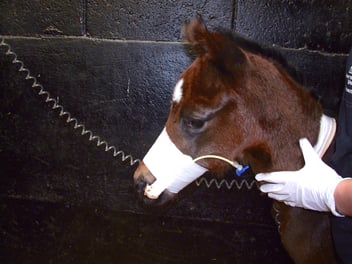Technique Tuesday - Measuring Blood Pressure in Newborn Foals
This Technique Tuesday, our co-founder and equine veterinary surgeon, Jennifer Corley, is sharing her expertise on Measuring Blood Pressure in Newborn Foals. Have questions or comments? Drop them in the comment form below, and Jennifer will be more than happy to help! Stay tuned for more exciting insights and techniques.

Technique for Measuring Blood Pressure in Newborn Foals
Objective:
Identifying and managing low blood pressure promptly in severely ill foals significantly impacts their prognosis. Prolonged low blood pressure can lead to irreversible organ damage, even if pressure levels are later stabilised.
Indications:
In cases of severe illness in foals, swift identification and treatment of low blood pressure significantly influence eventual outcomes. Persistent low blood pressure can lead to irreversible damage to vital organs, even if blood pressure is subsequently restored. Typically, although not always, the foal is lying down with markedly low blood pressure. The primary cause is usually neonatal sepsis, followed closely by perinatal asphyxia syndrome.
Equipment:
A blood pressure machine compatible with small blood pressure cuffs is essential. Some machines necessitate a specific hose to accommodate smaller cuffs.
· No. 4 neonatal cuff: 7-13cm (bladder width 52mm). Preferably soft cuffs.
Sites for Blood Pressure Monitoring:
The tail presents the most viable site for blood pressure measurement in foals. The coccygeal artery, situated on the ventral midline of the tail, is targeted. The cuff should be placed as close to the tail base as feasible, oriented so that the hose is positioned away from the foal's body. A reasonably snug fit of the cuff is necessary.
Normal Blood Pressure for Foals:
· Systolic pressure: 100-120mmHg (14.7-16 kPa)
· Diastolic pressure: 60-80mmHg (8-10.7 kPa)
A mean blood pressure less than 60mmHg (8 kPa) is an emergency for treatment.
Procedure for Measurement:
The machine automatically measures the blood pressure. The mean arterial blood pressure is the most accurate measurement method, while diastolic pressure is also sufficiently accurate for clinical use. However, measurements of systolic pressure are less accurate. In case of failure to obtain a reading:
1. Reposition the cuff.
2. Assess the patient; extreme hypotension might impede a reading.
3. Check the patient's heart rhythm, as cardiac dysrhythmia can affect readings.
4. Verify if the cuff inflates when the machine activates.
5. Inspect the cuff for leaks, submerging it in water may reveal leaks.
6. Try using the cuff at a different site.
7. Verify the machine's functionality by testing it on an adult (yourself) using an adult cuff.
8. Replace the machine if necessary.
Inconsistent measurements pose another common challenge. Steps to address this issue include:
1. Ensure the foal remains still during measurements.
2. Manually check the foal's heart rate; discard readings with inaccurate pulse rates.
3. Reposition the cuff.
4. Clinically assess the patient; extreme hypotension or dysrhythmia may cause measurement issues.
5. Perform five consecutive measurements. If three or more mean pressure measurements fall within 5-8mmHg of each other, it is likely close enough to the true mean pressure for clinical decision-making.
6. Follow the outlined steps to check both the cuff and the machine for any issues.




